Today's Menu consists of 2 main Japanese dishes taught to me (in Japanese) by Jeanette, my Japanese tutor. A round of applause for her. I'll be cooking:
-nikujaga (lit. meat'n'potatoes)
potatoes, carrots, onion, sliced beef, soy sauce, mirin, sake, sugar, dashi,
-fried renkon (lotus root)
1 renkon (lotus root), flour, corn starch, water, vineger, ground pork, grated ginger, green onion, oil for frying
...I'll also be "cooking":
-salad
whatever you like. I used chopped lettuce, carrots and a sesame dressing
--rice (of course)
Japanese white rice
First I start the rice:

After months of preparing my own Japanese meals, I have learned that I eat about 1 scoop of rice with a typical dinner, so I shovel a bit more than that amount into my rice-cooker pot --I want to make enough to have leftovers for tomorrow's bento-- and begin the long process of washing it. I fill and dump the pot with cold water 5 times, stirring it with my hands. This produces seemingly endless loads of cloudy water. Finally, the rice rinses just about clear and i can twist the faucet closed. In case you hadn't picked up on it, I am not a fan of washing rice. It's so tedious. In fact the Japanese word used to express the washing of rice is the same verb as honing a knife. Even half-assing it means a good 5 minutes running the tap feeling like a damn fool. But everyone agrees that washing rice is an important part of producing delicious flakey goodness; It removes excess starch and powder that is insidously mixed into the grains. Apparently you can buy "no-wash" (prewashed?) rice but I haven't seen it in my local grocery store yet. Until then, washing is a necessary evil. Anyway, i finish that and i set the pot into the cooker and just press start. it'll be ready in about half an hour.
Next let's take a look at the renkon, this strange Japanese vegetable. In English it's known as lotus root, though we don't really use it outside of the occasional very-authentic Japanese restaurant. Straight from the grocery store it looks like this:
 Yes, it's a muddy potato-shapped blob. I wash it off and peel it. Now it looks like this:
Yes, it's a muddy potato-shapped blob. I wash it off and peel it. Now it looks like this:
Then I slice it...

The internet-savvy among you will recognize this porous form as the pattern photoshopped into pictures of boobs that spread around the internet a number of years ago.I have omitted a photo for the sake of family and friends. sorry internet people, Google "lotus boob" for more information.
I take the sliced renkon, and let it soak in a solution of vinegar:



Sidenote: carrots and most other fruits and vegetables come needlessly (by my standards) packaged in plastic bags. You dont get to pick your own from a pile like in most US grocery stores.
Anyway, I let the vegetables sit in a bowl and I sprinkle instant Dashi and sake on them while they rest. By the way, dashi is a base used in almost all Japanese recipes. It is the broth in miso and clear soup. Dashi is made from boiling konbu (a type of seaweed) and any of a variety of small fish in water, and removing the skimmate. However, nowadays it is sold as an instant powder that can be dissolved in water:
By the way, dashi is a base used in almost all Japanese recipes. It is the broth in miso and clear soup. Dashi is made from boiling konbu (a type of seaweed) and any of a variety of small fish in water, and removing the skimmate. However, nowadays it is sold as an instant powder that can be dissolved in water:
 ...and I sautee the meat in a tablespoon or so of vegetable oil:
...and I sautee the meat in a tablespoon or so of vegetable oil: By the way, meat comes almost exclusively in the thin-sliced variety here in Japan because few Japanese recipes call for steak or chunks of meat (besides curry). Basically, most Japanese cooking techniques happen very quickly over a high heat, so thin-sliced meat is best as it does not require a long cooking time over a gentler heat. Traditionally Japanese cooking was developed by travelers. presumably katana-clad samurais who built fires, which is a pretty strong, uncontrolled heat. At any rate, steak is overpriced here and not very delicious. Even at Costco.
By the way, meat comes almost exclusively in the thin-sliced variety here in Japan because few Japanese recipes call for steak or chunks of meat (besides curry). Basically, most Japanese cooking techniques happen very quickly over a high heat, so thin-sliced meat is best as it does not require a long cooking time over a gentler heat. Traditionally Japanese cooking was developed by travelers. presumably katana-clad samurais who built fires, which is a pretty strong, uncontrolled heat. At any rate, steak is overpriced here and not very delicious. Even at Costco.oh yeah, i forgot about the onion! Ill need some of that too, so I slice one up while the meat sautees.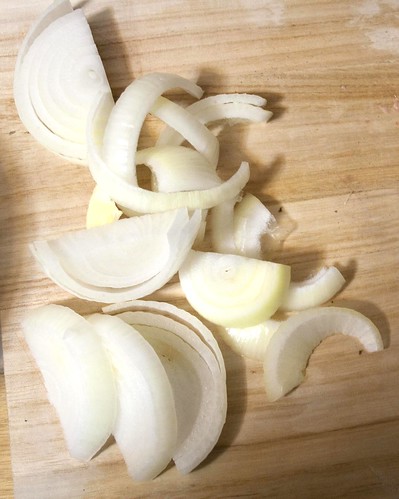
After the meat is browned, I toss in the potatoes, carrots and onions which have been soaking in that dashi goodness. I also add (just eyeballing it) about 2 tablespoons of Mirin (a japanese cooking wine), 2 tablespoons of sugar, 2 tablespoons of soy sauce, and about 2 cups of water. All of that starts to simmer together and work its magic:
Not unlike cheese, beef, tomato and tortilla to Mexican cooking, a few ingredients comprise the flavor of virtually all Japanese food:
From left to right- soy sauce, sake, mirin (a sweeter cooking sake), vinegar and sugar. Actually vinegar isn't always used and dashi IS always used, though it's not in this picture.
Anyway, I stir it all together and bring it to a boil. Then I reduce the heat and cover it. That will continue simmering for a long time, until most of the liquid has evaporated. As these ingredients begin dancing together and steam escapes, my house is starting to smell delicious. We are on the road to victory, people. "ii nioi" means "good smell."
Now I turn my attention back to the renkon. I pour some flour into a shallow bowl and coat each slice of lotus root on both sides. I rinse off my cutting board and lay out the slices there.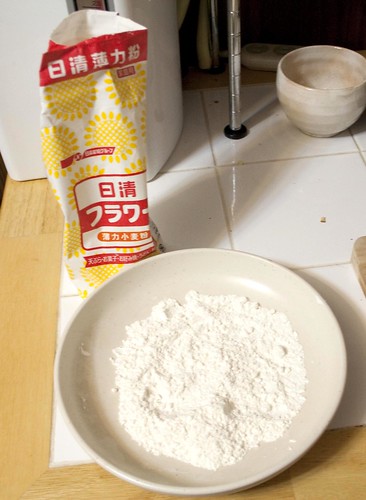
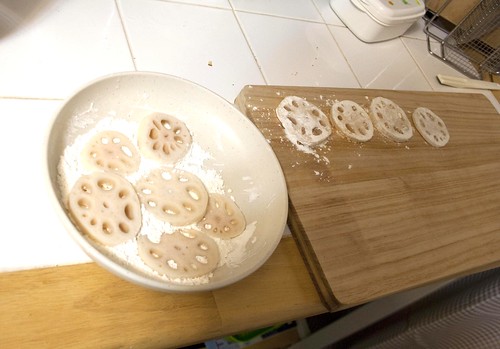
My rice is done at this point...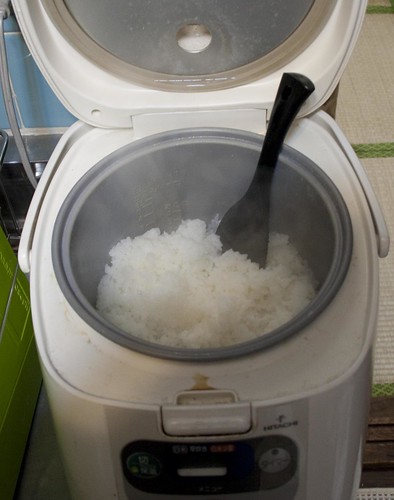
...but I am not finished cooking. i hope you internet people appreciate me slowing down so much to narrate to you, step by step. You're lucky I don't just pack up and leave. Anyway, the rice cooker will automatically keep my precious grains warm while i wrap this up. Yokatta.
Now I play the matching game with the renkon slices, trying to put together the pieces that were originally sliced consecutively because they will fit together perfectly. Using a mix of ground pork, grated ginger, and diced green onion, I make little renkon sandwiches: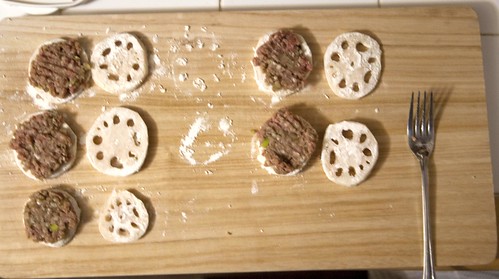

and now I mix equal parts flour and corn starch with water and a smidgeon of mayonaise (the mayo is Jeanette's suggestion, though she didn't use the word "smidgeon"). Meanwhile I heat some vegetable oil in a pan, and dip each renkon-pork sandwich into the batter mixture. You can guess what happens next:
I fry them for a minute or two on each side, until they turn golden brown. Then scooping them out and setting them on a plate over some kitchen paper.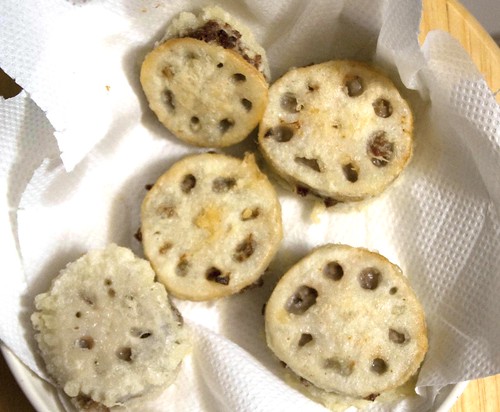
And my nikujaga is just about done reducing too! good timing! I prepare some soy sauce and spicy mustard to dip the renkon in and make a quick chopped salad.
And we're done! Itadakimasu!
I will enjoy all this with the local beer of choice. Kirin Draft is produced at the Kirin "beer farm" just down the road. It's a tasty, aromatic lagar.

oishii! US equivalent:


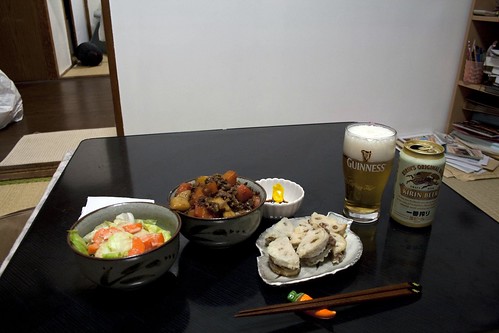
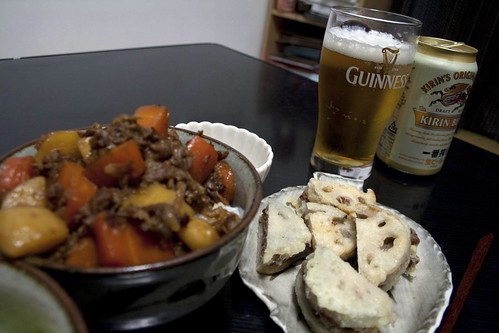

8 comments:
ALL YOUR PLATES ARE BELONG TO US.
hehehe
Looks amazing. Wish i could visit (with Jess) and eat it.
Congratulations! You can make my kyuushoku any time.
Food looks good, but Kirin Ichiban Shibori compared to Sam Adams!!!! Come on!
I have to admit, I am not a huge fan of Sam Adams, especially the regular lagar, and I AM a big fan of Kirin because there's a factory in my town.
So what would you compare Ichiban Shibori to in America? I am not well-versed enough in American lagers.
What a delicious dinner you had!Its a great fun having dinner with full family.I love it and i also try out this recipe.I will keep visiting for more such post.Thanks for sharing.
The kitchen is the most important part of the house. This area should pay attention to cleanliness and design. Personally, Here All the foods look are fresh. I like my kitchen look fresh and smell good.
Post a Comment